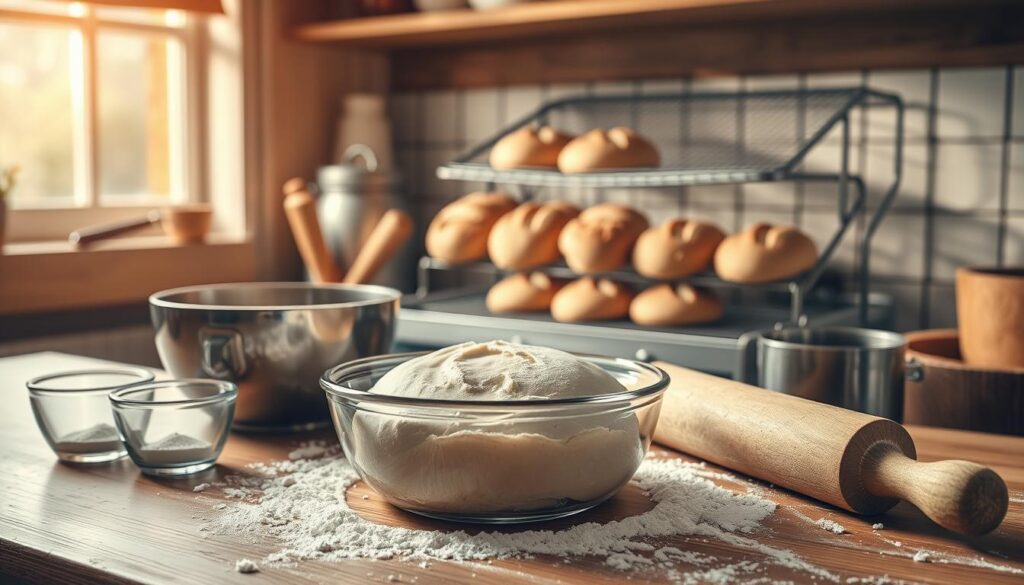Baking bread at home is like a mix of art and science. It’s a fun way to connect with a long-standing tradition. Whether you’re new or have baked before, making great bread starts with a few key steps. In this article, we’ll share top tips for bread to help you make amazing bread at home.
Homemade bread is better because it doesn’t have chemicals found in store-bought bread. You can choose what goes into it, like sugar and salt. Plus, homemade whole grain bread is full of good stuff like fiber and vitamins.
As we share more tips for baking at home, remember it’s also good for your mind. Making dough and baking a loaf can make you feel proud. Sharing it with others can also bring people together.
Understanding the Basics of Bread-Making
Bread-making starts with knowing the main ingredients and steps. It’s a simple yet detailed process. Making your own bread is very rewarding.
Choosing good ingredients is key for great taste and texture. Yeast is vital in making the dough rise. Kneading helps the dough get chewy.
Homemade bread has no bad chemicals. It’s full of fiber, vitamins, and minerals. You can make it healthier by changing the recipe.
Baking bread is calming and makes you feel good. It connects you to history. Sharing bread brings people together.
Learning to make bread is fun. It’s not just about food. It’s about joy, connection, and health.

Choose High-Quality Ingredients
Choosing the right ingredients is key in making great bread. High-quality flour, with more protein, gives bread its chewy texture. Fresh yeast is also important. It makes the bread light and fluffy.
Using clean water helps make better-tasting bread. Salt adds flavor and helps the dough rise better. These ingredients make your bread-making journey special and healthy.
Temperature Matters in Bread Baking
Temperature is very important in bread baking. It helps yeast work well. Ingredients like flour, water, and fat should be at room temperature.
Preheat your oven well. The best temperature is between 375°F and 475°F. This makes the crust perfect and keeps the bread moist.
A hot oven makes the bread look and taste great. It gives the bread a nice texture.
Check the bread’s inside temperature. It should be between 190°F and 210°F. This means the bread is cooked right. It keeps the moisture in and makes the crust golden.
Mastering Kneading Techniques
Dough kneading is key in bread-making. It makes the flour and water mix into a dough that can rise. You can knead by hand or use a stand mixer with a dough hook.
Hand-kneading needs rhythm and the right pressure. Knead for 10 minutes until the dough is smooth and a bit tacky. If using a stand mixer, keep it on low speed. The dough should pull away from the bowl.
Knowing when the dough is ready is important. Do a stretch test: a good dough stretches thin without tearing. This shows the dough is ready for baking. Learning these kneading skills helps make great bread at home.
Importance of Resting the Dough
Resting the dough after kneading is key in bread-making. It’s called bulk fermentation. This time lets the dough rest, which relaxes the gluten.
The yeast starts working, making the dough rise a lot. Often, it doubles in size. A rested dough makes the bread fluffier and tastier.
It’s vital to cover the dough and keep it away from drafts. The best temperature is 75°F to 85°F. This helps the dough get better flavors and texture.
If the dough doesn’t rest enough, the bread might be dense. It won’t be as light as a well-made loaf.
The dough’s water content also matters. More water means a lighter, airier bread. So, resting the dough is very important.
In short, taking time to rest the dough makes a big difference. It shows how patience is important in making bread.
5 Tips for Making the Best Bread
Want to make better bread at home? Here are five tips to help. They’ll make your loaves tasty and fun to eat.
First, use the best ingredients. Fresh flour, pure yeast, and clean water matter a lot. Organic or local ingredients taste better and are healthier.
Don’t skip kneading. It makes the dough chewy. Practice kneading to get it right.
Let the dough rise well. This makes the bread taste and feel better. Be patient, it’s worth it.
Preheat your oven well. This makes the bread cook evenly and get a nice crust. Wait until it’s hot before baking.
Cool your bread on a rack. It keeps it from getting soggy. It also makes the flavors better.
Baking: The Key to Perfect Crust
Baking bread is where the magic happens. To get a crispy crust, preheat the oven well. Make sure it’s hot before putting in your dough.
Creating steam in the oven helps too. You can use a baking dish with hot water or spray water on the bread. This makes the crust crispy and delicious.
Knowing when your bread is done is key. It should look golden and sound hollow when tapped. Check the inside temperature for best results. It should be 190-200°F (88-93°C).
After baking, let the bread cool for 30 minutes. This helps the crust set right before you slice it.
Understanding Fermentation and Rising
The fermentation process is key in bread-making. It makes the bread taste good and feel right. Yeast eats the sugars in the dough, making carbon dioxide. This gas makes the dough grow bigger.
This growing is called dough rising. Getting good at this can really improve your bread. Bulk fermentation and proofing are important steps.
Bulk fermentation is the first rise. It helps the dough get strong and the flavors to grow. Shaping the dough right is also key. It affects how it rises again.
This second rise makes the bread’s inside better. It makes the bread taste and feel even better.
Knowing about these steps helps bakers make great bread. It’s not just about making bread. It’s about making something special, with every slice.
Cooling and Storing Your Bread
After baking, it’s key to cool your bread right. Let it cool on a wire rack before you slice it. Cutting too soon makes it soggy.
For storing, you have many choices. A bread box or paper bag keeps it fresh for days. Freezing is great for longer storage. Wrap it well to keep flavors and texture good.
Don’t throw away stale bread. Refresh it by spraying with water and baking at 350°F for 10 minutes. This makes it crispy again. Good cooling and storage keep bread fresh longer.
Want more baking tips? Check out this guide. It has lots of helpful advice. Also, see culinary trends to learn more.
Conclusion
As we finish this bread-making guide, it’s clear that making homemade bread is both a science and an art. You need to know how to knead right, use the best ingredients, and let the dough ferment well. Each step, from kneading to baking, is important for making great bread.
Letting the bread cool down and storing it right keeps it fresh. Sharing your homemade bread is a way to show off your skills and creativity. By following these steps, you make bread that your loved ones will love.
Baking bread is a fun journey that lets you try new things and join baking groups. Every loaf you make brings you closer to being a pro baker. Enjoy the journey and the yummy bread you make!
FAQ
What are the essential ingredients needed for making bread?
To make great bread, use top-notch ingredients. Choose bread flour with more protein. Use fresh yeast for a good rise.
Use filtered water to avoid dirt. Salt makes the bread taste better and helps the gluten.
How can I tell when my dough is ready for baking?
The dough is ready when it feels smooth and elastic. Do a texture test by stretching a small piece.
If it forms a thin membrane without tearing, it’s ready. This means the gluten is developed well.
Why is the resting period important in bread-making?
Resting the dough is key. It lets gluten relax and yeast work. This makes the bread airy and flavorful.
It helps the dough rise properly.
What should I do to achieve a crispy crust on my bread?
For a crispy crust, preheat your oven well. Create steam early in baking. This makes the crust golden.
Can I use any type of container for fermenting dough?
Choose a big container for the dough to rise. Cover it with a damp cloth or plastic wrap.
Keep it in a place without drafts. This helps fermentation.
How should I store my homemade bread to maintain its freshness?
Store bread at room temperature in a bread box or cloth. You can freeze it for longer.
To refresh stale bread, mist it with water and warm it in the oven.
What is the difference between bulk fermentation and proofing?
Bulk fermentation is the first rise after kneading. Proofing is the second rise after shaping.
Both are important for flavor and texture. They let yeast ferment the dough more.







